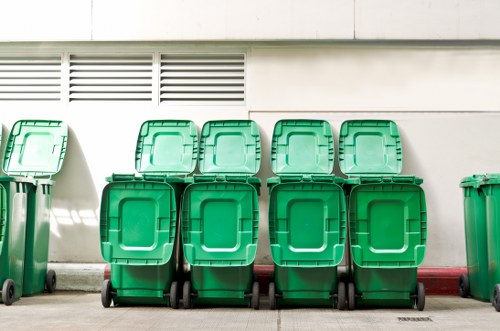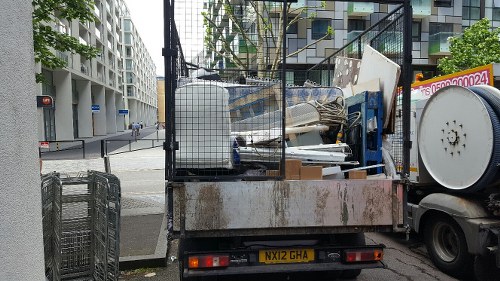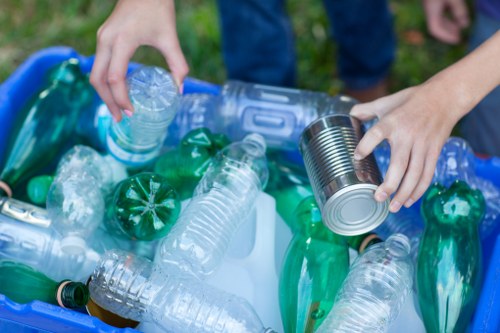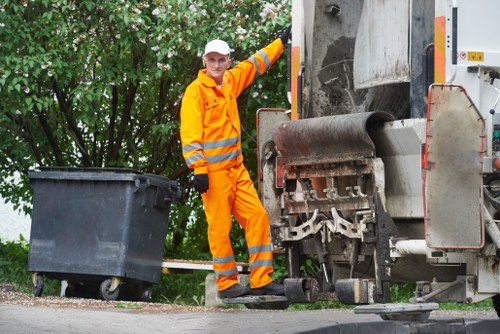Construction Waste Clearance in Hornsey

Construction waste clearance plays a crucial role in maintaining a clean and safe environment in Hornsey. Whether you're undertaking a major renovation or a small building project, managing the debris and waste generated is essential for both safety and compliance.
Proper waste clearance ensures that your construction site remains organized, reducing the risk of accidents and facilitating smoother project management. It also helps in minimizing the environmental impact by promoting recycling and responsible disposal practices.
In Hornsey, there are specific regulations and guidelines that govern how construction waste should be handled. Adhering to these rules is not only a legal requirement but also a commitment to sustainability and community well-being.
Why is Construction Waste Clearance Important?

Effective waste clearance is essential for several reasons:
- Safety: Removing debris and waste reduces the risk of accidents on-site.
- Compliance: Meeting local regulations avoids potential fines and legal issues.
- Environmental Protection: Proper disposal and recycling minimize the environmental footprint of your project.
- Site Efficiency: A clean site enhances productivity and makes it easier to manage construction activities.
- Aesthetic Appeal: Maintaining a tidy site improves the overall appearance and perception of the project.
In Hornsey, these factors are particularly important due to the area's commitment to sustainability and community standards. Ensuring that your construction waste is managed responsibly aligns with local values and contributes to the neighborhood's overall attractiveness.
Moreover, efficient waste clearance can lead to cost savings by reducing the need for additional labor and equipment to handle cluttered or hazardous materials on-site.
Types of Construction Waste

Understanding the different types of construction waste is the first step in effective waste clearance. Common categories include:
- Concrete and Masonry: Includes broken bricks, blocks, and concrete slabs.
- Wood: Lumber offcuts, pallets, and untreated timber.
- Metals: Steel beams, rebar, and aluminum scraps.
- Plastics: Packaging materials, PVC pipes, and insulation.
- Drywall: Sheets of gypsum board and related materials.
- Hazardous Waste: Paints, solvents, and asbestos-containing materials.
Each type of waste requires specific handling and disposal methods to comply with Hornsey's regulations and to promote recycling where possible.
Identifying and segregating waste on-site can streamline the clearance process and enhance recycling efforts, contributing to a more sustainable construction practice.
Local Regulations and Compliance

Hornsey has established strict regulations to manage construction waste effectively. Compliance with these rules ensures that your project does not negatively impact the local environment or community.
- Waste Segregation: Different types of waste must be separated at the source to facilitate recycling.
- Permits and Licensing: Contractors may need specific permits to transport and dispose of certain types of waste.
- Recycling Requirements: A percentage of construction waste must be recycled, reducing the amount sent to landfills.
- Hazardous Waste Handling: Special procedures must be followed for the disposal of hazardous materials to prevent environmental contamination.
- Record-Keeping: Detailed records of waste disposal must be maintained for inspection and compliance purposes.
Adhering to these regulations not only ensures legal compliance but also demonstrates a commitment to environmental stewardship and community responsibility.
Working with a professional waste clearance service in Hornsey can help navigate these regulations, ensuring that all legal requirements are met efficiently.
Methods of Construction Waste Clearance

There are several methods for clearing construction waste, each suited to different types of projects and waste materials:
1. On-Site Sorting: Segregating waste on-site allows for easier recycling and disposal of materials.
2. Bulk Collection: Scheduling regular bulk pickups can prevent the accumulation of waste and maintain a clean work environment.
3. Recycling Facilities: Partnering with local recycling facilities ensures that materials like metal, wood, and concrete are processed responsibly.
On-Site Sorting
Implementing on-site sorting systems helps in categorizing waste as it is generated. This practice enhances recycling efforts and reduces the volume of waste that needs to be transported.
Benefits include:
- Increased recycling rates
- Reduced disposal costs
- Improved site organization

Proper sorting can significantly impact the efficiency of waste clearance, making it easier to manage different types of debris and ensuring compliance with local regulations.
It also fosters a culture of environmental responsibility among workers, contributing to a more sustainable construction process.
In Hornsey, where sustainability is a key community value, on-site sorting is particularly beneficial.
Bulk Collection
Bulk collection involves scheduling regular pickups of construction waste, preventing the accumulation of debris on-site. This method is ideal for larger projects where waste generation is consistent and substantial.
Advantages:
- Maintains a clean and safe work environment
- Reduces the risk of accidents caused by cluttered sites
- Facilitates timely waste disposal
In Hornsey, bulk collection services are available to accommodate the needs of different projects, ensuring that waste is managed efficiently and in compliance with local guidelines.

By scheduling bulk pickups, construction managers can focus more on their projects, knowing that waste clearance is handled systematically.
This approach also helps in adhering to project timelines by preventing delays caused by waste accumulation.
Efficient bulk collection supports the overall productivity and success of construction projects in Hornsey.
Recycling Facilities
Utilizing local recycling facilities is a sustainable way to manage construction waste. These facilities process various materials, turning waste into reusable resources.
Key benefits:
- Reduces the environmental impact of construction
- Saves costs by recycling materials instead of disposing of them
- Supports the local economy by partnering with community-based facilities
In Hornsey, several recycling centers specialize in handling construction debris, ensuring that materials like metal, wood, and concrete are processed responsibly.
Collaborating with these facilities not only promotes sustainability but also helps in meeting regulatory requirements for waste management.

Recycling facilities play a pivotal role in transforming construction waste into valuable resources, contributing to a circular economy in Hornsey.
This sustainable approach aligns with global environmental goals, positioning Hornsey as a forward-thinking community in construction practices.
Engaging with local recycling centers enhances the overall impact of your construction project on the environment.
Environmental Benefits of Proper Waste Clearance

Responsible construction waste clearance offers numerous environmental benefits:
- Reduced Landfill Use: Minimizing waste sent to landfills conserves space and decreases the burden on waste management systems.
- Resource Conservation: Recycling materials reduces the need for raw resources, preserving natural habitats and ecosystems.
- Lower Carbon Footprint: Efficient waste management practices decrease greenhouse gas emissions associated with waste transportation and decomposition.
- Pollution Prevention: Proper disposal of hazardous materials prevents soil and water contamination.
- Energy Savings: Recycling materials often require less energy compared to producing new materials from scratch.
In Hornsey, these environmental advantages support the community's sustainability goals and contribute to a healthier, greener environment for residents.
Adopting eco-friendly waste clearance practices can significantly impact the overall environmental footprint of construction projects, making them more sustainable and responsible.
Choosing the Right Waste Clearance Service

Selecting a reliable waste clearance service is vital for the success of your construction project. Consider the following factors when making your choice:
- Experience and Expertise: Ensure the service provider has a proven track record in handling construction waste.
- Compliance: Verify that the company adheres to local regulations and environmental standards.
- Services Offered: Look for comprehensive services, including waste collection, sorting, recycling, and disposal.
- Pricing: Compare pricing models to find a service that fits within your budget without compromising quality.
- Customer Reviews: Read testimonials and reviews to gauge the satisfaction of previous clients.
In Hornsey, numerous waste clearance services are available, each offering different packages and specializations. Taking the time to research and select the right provider can ensure efficient and compliant waste management for your project.
Additionally, partnering with a professional service can provide peace of mind, knowing that waste clearance is being handled responsibly and effectively.
Evaluating Service Providers
When evaluating potential waste clearance services, consider the following steps:
- Research the company's background and history in the industry.
- Assess their range of services and whether they align with your project's needs.
- Inquire about their waste management processes and recycling initiatives.
- Request quotes and compare pricing structures.
- Check for necessary certifications and licenses to operate in Hornsey.
By thoroughly evaluating service providers, you can select a partner that not only meets your waste clearance needs but also aligns with your project's sustainability goals.
Effective collaboration with the right service provider can lead to smoother project execution and enhanced environmental responsibility.
Assessing Pricing and Value
While cost is an important consideration, it should not be the sole factor in choosing a waste clearance service. Evaluate the value offered by the provider in terms of:
- Quality of Service: Ensure the company delivers prompt and reliable services.
- Range of Services: Comprehensive offerings may reduce the need for multiple contractors.
- Environmental Practices: Services that prioritize recycling and responsible disposal add value beyond basic clearance.
- Customer Support: Responsive and helpful customer service can enhance the overall experience.
In Hornsey, investing in a quality waste clearance service can lead to long-term benefits, including compliance, environmental stewardship, and efficient project management.
Ultimately, the goal is to find a balance between cost and the quality of services provided, ensuring that your construction waste is managed effectively without exceeding your budget.
The Waste Clearance Process

Understanding the waste clearance process can help you manage your construction project more effectively. The typical steps involved include:
- Assessment: Evaluating the types and quantities of waste generated by the project.
- Planning: Developing a waste management plan that outlines sorting, collection, and disposal methods.
- Implementation: Executing the waste management plan by segregating, collecting, and transporting waste.
- Disposal: Properly disposing of or recycling waste materials in accordance with local regulations.
- Monitoring: Continuously overseeing the waste clearance process to ensure compliance and efficiency.
Each stage of the process is critical in ensuring that construction waste is managed responsibly and efficiently.
By following a structured approach, you can mitigate risks, enhance sustainability, and maintain a productive construction environment.
Initial Assessment
The first step in the waste clearance process is conducting a thorough assessment of the construction site. This involves identifying the types and quantities of waste that will be produced, as well as any specific handling requirements for different materials.
Key activities include:
- Surveying the site to determine waste sources
- Classifying waste materials
- Estimating waste volumes
- Identifying recycling opportunities
This assessment helps in creating an effective waste management plan tailored to the project's needs.
In Hornsey, considering local recycling facilities and disposal options during the assessment can enhance the sustainability of your waste clearance efforts.

Accurate assessment ensures that all waste is accounted for and managed appropriately, preventing environmental hazards and ensuring compliance with regulations.
It also aids in budgeting for waste clearance services and scheduling pickups, contributing to a more organized and efficient project timeline.
Effective initial assessment lays the foundation for successful waste management throughout the construction process.
Developing a Waste Management Plan
Once the assessment is complete, the next step is to develop a comprehensive waste management plan. This plan outlines how waste will be sorted, collected, and disposed of or recycled.
Components of the plan include:
- Sorting guidelines for different types of waste
- Scheduling for regular pickups and removals
- Selection of disposal and recycling facilities
- Roles and responsibilities of team members
- Monitoring and reporting procedures
A well-crafted waste management plan ensures that waste clearance is handled systematically and in alignment with both project goals and regulatory requirements.
In Hornsey, collaborating with local waste clearance services during the planning phase can enhance the effectiveness of your waste management strategy.

A detailed plan helps in organizing resources effectively, reducing the likelihood of waste accumulation and ensuring timely disposal or recycling.
It also provides a clear roadmap for site workers, facilitating smoother implementation of waste clearance activities.
Having a structured plan in place contributes to the overall success and sustainability of your construction project.
Recycling and Disposal Options

Exploring various recycling and disposal options is key to effective waste clearance. Proper management ensures that materials are handled in an environmentally responsible manner.
Common Options Include:
- Recycling: Processing materials like metal, wood, and concrete for reuse.
- Hazardous Waste Disposal: Specialized handling and disposal of hazardous materials to prevent environmental contamination.
- Landfill Disposal: Safe and regulated disposal of non-recyclable waste materials.
- Composting: Biodegradable waste can be composted to create valuable soil amendments.
In Hornsey, utilizing local recycling centers and adhering to disposal guidelines ensures that waste is managed sustainably and in compliance with regulations.
Choosing the appropriate disposal method for each type of waste enhances the overall efficiency and environmental impact of your construction project.
Maximizing Recycling Efforts
Maximizing recycling efforts involves not only segregating waste but also actively seeking opportunities to reuse materials.
Strategies include:
- Designing projects that incorporate recycled materials
- Partnering with suppliers who prioritize sustainable practices
- Educating workers on the importance of recycling and proper sorting
In Hornsey, a strong emphasis on recycling supports the community's environmental goals and fosters a culture of sustainability within the construction industry.
By integrating recycling into your waste management practices, you contribute to resource conservation and reduce the environmental footprint of your project.

Effective recycling not only benefits the environment but can also lead to cost savings by reducing the need for new materials.
It enhances the reputation of your project as being environmentally responsible, which can be a significant advantage in a community that values sustainability.
Maximizing recycling efforts is a win-win approach, benefiting both your project and the broader Hornsey community.
Challenges in Construction Waste Clearance

Despite the benefits, managing construction waste clearance can present several challenges:
- Logistical Issues: Coordinating waste collection and transportation can be complex, especially for large projects.
- Cost Constraints: Budget limitations may affect the ability to implement comprehensive waste management strategies.
- Regulatory Compliance: Navigating local regulations requires knowledge and attention to detail.
- Recycling Limitations: Not all materials may be recyclable, necessitating proper disposal methods.
- Space Limitations: Limited on-site space can make waste storage and sorting challenging.
Addressing these challenges requires careful planning, effective communication, and collaboration with experienced waste clearance services.
In Hornsey, overcoming these obstacles is achievable by leveraging local resources and adhering to best practices in waste management.
Managing Logistics
Efficiently managing the logistics of waste clearance involves scheduling pickups, ensuring adequate transportation, and coordinating with disposal facilities.
Solutions:
- Establishing a clear schedule for waste collection
- Using appropriate containers and storage areas on-site
- Collaborating with reliable waste clearance providers
In Hornsey, partnering with local waste management companies can streamline logistical operations, ensuring timely and efficient waste clearance.
Effective logistics management reduces downtime and maintains project momentum, contributing to successful project completion.

Proper logistics ensure that waste does not accumulate on-site, maintaining a safe and organized work environment.
It also facilitates better communication between project managers and waste clearance services, enhancing overall efficiency.
Addressing logistical challenges head-on leads to more effective and stress-free waste management.
Budgeting for Waste Clearance
Allocating sufficient budget for waste clearance is essential, but it can be challenging due to varying project scales and waste volumes.
Strategies include:
- Estimating waste quantities during the planning phase
- Comparing quotes from multiple waste clearance providers
- Incorporating recycling incentives and discounts
- Prioritizing waste reduction to minimize costs
In Hornsey, competitive pricing among waste clearance services means that with careful planning, effective waste management can be achieved within budget constraints.
Balancing cost with quality ensures that waste clearance does not compromise the overall project budget or environmental standards.
Best Practices for Construction Waste Clearance

Implementing best practices in waste clearance enhances efficiency, compliance, and sustainability. Key practices include:
- Early Planning: Incorporate waste management strategies from the project's inception.
- Consistent Training: Educate workers on proper waste handling and segregation techniques.
- Regular Monitoring: Continuously assess waste management processes to identify and address issues.
- Engagement with Stakeholders: Collaborate with suppliers, contractors, and waste clearance services to optimize waste management.
- Adoption of Technology: Utilize software and tools to track waste generation and disposal.
By adhering to these best practices, construction projects in Hornsey can achieve higher levels of efficiency and environmental responsibility.
These practices not only enhance the effectiveness of waste clearance but also contribute to the overall success and reputation of the project.
Continuous Improvement
Waste clearance is not a one-time activity but an ongoing process that benefits from continuous improvement.
Approaches to improvement:
- Regularly reviewing waste management policies
- Incorporating feedback from team members
- Staying updated with the latest waste management technologies
- Setting and evaluating waste reduction goals
In Hornsey, embracing a culture of continuous improvement ensures that waste clearance practices remain effective and aligned with evolving standards and community expectations.
It also encourages innovation and the adoption of more sustainable and efficient waste management solutions.

Continuous improvement leads to more streamlined waste management processes, reducing costs and enhancing environmental outcomes.
It fosters a proactive approach to waste clearance, addressing challenges before they escalate into larger issues.
Embracing ongoing improvement aligns waste management practices with the dynamic nature of construction projects and environmental priorities.
Benefits of Professional Waste Clearance Services

Engaging professional waste clearance services offers numerous advantages:
- Expertise: Professionals bring specialized knowledge and experience in managing diverse types of construction waste.
- Efficiency: Streamlined processes and adequate resources ensure timely waste clearance.
- Compliance: Experts stay updated with local regulations, ensuring adherence and avoiding legal issues.
- Sustainability: Professional services prioritize recycling and eco-friendly disposal methods.
- Cost-Effectiveness: Efficient waste management can lead to long-term savings by reducing waste volumes and optimizing disposal costs.
In Hornsey, professional waste clearance services are equipped to handle the unique challenges posed by local construction projects, providing tailored solutions that meet specific needs.
Their comprehensive approach ensures that waste clearance is managed seamlessly, allowing construction managers to focus on core project activities.
Time Savings
Professional waste clearance services save valuable time by handling the logistics of waste management, allowing construction teams to concentrate on their tasks.
Benefits include:
- Reduced downtime associated with waste sorting and removal
- Faster project completion due to efficient waste management
- Less administrative burden related to regulatory compliance
In Hornsey, time efficiency is particularly beneficial for projects adhering to tight schedules and deadlines.
By outsourcing waste clearance, construction teams can enhance productivity and maintain project momentum without the distraction of managing waste internally.

Time saved through professional services can be redirected towards other critical aspects of the construction project, enhancing overall efficiency and success.
It also reduces the likelihood of delays caused by waste accumulation, ensuring smoother project flow.
Efficient time management contributes to meeting project milestones and maintaining client satisfaction.
Enhanced Sustainability
Professional waste clearance services in Hornsey prioritize sustainability by implementing practices that minimize environmental impact.
Key practices include:
- Maximizing recycling rates
- Utilizing eco-friendly disposal methods
- Reducing overall waste generation through innovative solutions
- Adhering to green building standards
These sustainable practices not only benefit the environment but also enhance the reputation of your construction project as being environmentally responsible.
Incorporating sustainability into waste clearance aligns with global environmental goals and local community values, fostering a positive perception of your project.
Cost Considerations in Waste Clearance

Managing the costs associated with construction waste clearance is essential for maintaining budgetary control. Key factors influencing costs include:
- Volume of Waste: Larger volumes typically incur higher disposal and transportation fees.
- Type of Waste: Hazardous or non-recyclable materials may require specialized handling, increasing costs.
- Frequency of Collection: Regular pickups may offer cost savings compared to ad-hoc services.
- Recycling Rates: Higher recycling rates can reduce disposal costs through recycling incentives.
- Service Provider Rates: Different providers offer varying pricing structures based on service quality and offerings.
In Hornsey, competitive pricing among waste clearance services allows for flexibility in budgeting, enabling projects of all sizes to find suitable solutions.
Effective cost management involves balancing the need for comprehensive waste clearance with budget constraints, ensuring financial sustainability without compromising on environmental responsibilities.
Budget Planning
Integrating waste clearance costs into the overall project budget is crucial for financial planning.
Approaches include:
- Estimating waste volumes based on project scope
- Allocating funds for waste management services
- Contingency budgeting for unexpected waste disposal needs
- Exploring cost-saving measures like increased recycling rates
In Hornsey, meticulous budget planning ensures that waste clearance does not lead to unforeseen financial burdens, allowing for smoother project execution.
By anticipating and allocating resources effectively, construction managers can prevent budget overruns related to waste management.

Proper budget planning for waste clearance contributes to overall project financial health and ensures that waste management goals are achievable within budget constraints.
It also facilitates informed decision-making when selecting waste clearance services that offer the best value for money.
Strategic budgeting supports the sustainable and cost-effective management of construction waste in Hornsey.
Cost-Saving Opportunities
Several strategies can help reduce the costs associated with construction waste clearance:
- Maximizing recycling to lower disposal fees
- Minimizing waste generation through efficient material use
- Negotiating bulk service rates with waste clearance providers
- Implementing on-site waste sorting to streamline processes
- Leveraging government incentives for sustainable waste practices
In Hornsey, these cost-saving measures can be particularly effective, given the availability of local recycling centers and competitive service rates.
By embracing these opportunities, construction projects can achieve both financial and environmental benefits, enhancing overall project viability.
Conclusion

Effective construction waste clearance in Hornsey is a critical component of successful and sustainable construction projects. By understanding the importance of waste management, adhering to local regulations, and implementing best practices, you can ensure that your project remains organized, compliant, and environmentally responsible.
Partnering with professional waste clearance services enhances efficiency, compliance, and sustainability, allowing you to focus on the core aspects of your construction project.
Embrace responsible waste management today to contribute positively to the Hornsey community and the environment.
Take Action Now
If you're planning a construction project in Hornsey, don't overlook the importance of waste clearance. Contact us today to schedule your waste clearance service and ensure your project adheres to the highest standards of safety and sustainability.
Book your service now and take the first step towards a cleaner, more efficient construction site.
Hornsey Skip Hire
Discover essential strategies and best practices for effective construction waste clearance in Hornsey, ensuring compliance, sustainability, and efficiency for your projects.









